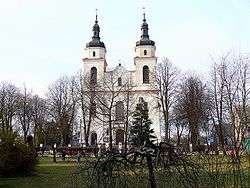Jedwabne
| Jedwabne | ||
|---|---|---|
 Saint Jacob Church | ||
| ||
 Jedwabne | ||
| Coordinates: 53°17′N 22°18′E / 53.283°N 22.300°E | ||
| Country |
| |
| Voivodeship | Podlaskie | |
| County | Łomża | |
| Gmina | Jedwabne | |
| Area | ||
| • Total | 11.47 km2 (4.43 sq mi) | |
| Population (2006) | ||
| • Total | 1,901 | |
| • Density | 170/km2 (430/sq mi) | |
| Postal code | 18-420 | |
| Website | http://www.jedwabne.pl/ | |
Jedwabne (pronounced [jed'vabne]; Yiddish: יעדוואבנע, Yedvabna) is a town in northeast Poland, in Łomża County of Podlasie Province, with 1,942 inhabitants (2002). It is notable for the Jedwabne pogrom of 10 July 1941, during the World War II German occupation of Poland.
History

First mentioned in 1455 records, on 17 July 1736 Jedwabne received city rights from Poland's King August III, including the privilege of holding weekly Sunday markets and five country fairs a year. A wooden Catholic church with two steeples was built in 1737–1738, and a synagogue around 1770. The Jedwabne synagogue was a fine example of the unique Polish Jewish architectural tradition of wooden synagogues.[1]
At the end of the 18th century, new textile factories opened. In 1851 there were as many as 17 weaving establishments employing 36 workers in the town. In terms of its cloth production, Jedwabne was already the eleventh-largest manufacturing centre in the Kingdom of Poland. By 1862, 11 mechanical and 13 manual weaving machines had been installed at Jedwabne. The town's cloth production fell into decline only after the January Uprising of 1863, due to Russian repression against Polish and Jewish entrepreneurs. The town was the center of a large Jewish community with a population in 1900 of 1,941.[2]
Jedwabne pogrom
Following the Soviet invasion of eastern Poland in World War II in fulfillment of the Molotov–Ribbentrop Pact, between 1939 and 1941 the Soviet NKVD conducted anti-Polish repression. It was preceded by a successful Soviet attack against a Polish partisan unit stationed in the Kobielne Wilderness. In 1940 the town had 3,985 residents: 3,670 Poles, 250 Jews, and 65 Belarusians.[3] The NKVD arrested a number of Poles and their families and deported them to Siberia. The NKVD arrested and killed Parson Ryszard Marian Szumowski.
Soon after the German takeover of Jedwabne during the 1941 attack on the Soviet zone of occupied Poland (part of Operation Barbarossa), the town became the site of the now infamous Jedwabne pogrom on 10 July 1941. Some 40 Jewish men were killed by Nazis in a barn belonging to Bronisław Śleszyński.[4][5] It was later followed by the murders of a group of an estimated 300 additional Jewish victims with families, who were locked in the same barn, which was set on fire by Polish men in the presence of German policemen. Some of the Poles were tried for this crime after the war.[6] These events were long covered by silence, but beginning in the late 20th century, reports were published about them.
The next day, according to witness accounts, the Germans created a ghetto in Jedwabne (July 11, 1941) and incarcerated about 100-130 Jews in it. They were shipped to Łomża Ghetto in November 1941, and subsequently sent to the extermination camp at Treblinka.[7]
In the early 20th century many Jedwabne residents had emigrated to the United States. Landing and settling in New York City, they built the synagogue Congregation Anshe Yedwabne at 242 Henry Street in the Lower East Side.[8]
Economy
Jedwabne is the administrative and economic centre for the surrounding gmina, which has an agricultural character. It offers educational and healthcare services for the community, as well as administrative support, business infrastructure, and investment financing.[9] The town is flanked by the Biebrza National Park, the biggest complex of natural marshes in Central Europe; it is inhabited by moose as well as other animals and bird species, attracting numerous tourists. The Biebrza river nearby is surrounded by campgrounds for fishing, hiking, and mountain biking. Agrotourism substantially contributes to the local economy, with prolonged tourist season beginning on March 1 and lasting until October 30 each year.[10]
See also
Notes
- ↑ Maria and Kazimierz Piechotka, Heaven's Gate: Wooden Synagogues in the Territory of the Former Plish-Lithuanian Commonwealth, Institute of Art, Polish Academy of Sciences, Wydawnnictwo Krupski I S-ka, Warsaw, 2004, pp. 231-32.
- ↑ JewishGen.org
- ↑ (in Polish) D. Boćkowski. Na zawsze razem. Białostocczyzna i Łomżyńskie w polityce radzieckiej w czasie II wojny światowej (IX 1939 – VIII 1944). Neriton, Instytut Historii PAN. 2005. p. 120.
- ↑ Komunikat dot. postanowienia o umorzeniu śledztwa w sprawie zabójstwa obywateli polskich narodowości żydowskiej w Jedwabnem w dniu 10 lipca 1941 r. Archived 2013-06-20 at the Wayback Machine. (A communiqué regarding the decision to stop investigation of the murder of Polish citizens of Jewish nationality in Jedwabne on 10 July 1941) from 30 June 2003
- ↑ "Insight Into Tragedy". The Warsaw Voice, 17 July 2003.
- ↑ Tomasz Strzembosz, "Inny obraz sąsiadów", Rzeczpospolita, 31.03.01 Nr 77
- ↑ (Polish) The 90th session of the Senate of the Republic of Poland. Stenograph, part 2.2. Archived 2008-04-23 at the Wayback Machine. A Report by Leon Kieres, president of the Institute of National Remembrance, for the period from July 1, 2000 to June 30, 2001. Donald Tusk presiding. See statement by Senator Jadwiga Stokarska.
- ↑ Yedwabne Yizkor Book, Radzilow
- ↑ "Gmina Jedwabne". Urząd Miejski w Jedwabnem. 2008. Retrieved September 17, 2012.
- ↑ "Walory turystyczne". Urząd Miejski w Jedwabnem. 2008. Retrieved September 17, 2012.
References
- Official town website
- Jedwabne Yizkor (Holocaust Memorial) Book (Hebrew, Yiddish and English), online at the New York Public Library
- Jedwabne - A Bibliography by LitDok East-Central Europe / Herder-Institut (Marburg)
- W czterdziestym nas matko na Sybir zesłali" - Polska a Rosja 1939-42, Wybór i opracowanie: Jan Tomasz Gross, Irena Grudzińska-Gross. Wstęp napisał Jan Tomasz Gross. Wybór dziecinnych wypracowań polskich dzieci uwolnionych z sowieckiej zsyłki lat 1939-1942 ze zbiorów Instytutu Hoovera. Londyn: Aneks 1983.
